Cathodoluminescence of Ultrathin InAs Layers Embedded in GaAs Matrix
Abstract
:1. Introduction
2. Materials and Methods
2.1. Growth of Samples
2.2. Characterization and Simulation
3. Results and Discussion
4. Conclusions
Author Contributions
Funding
Data Availability Statement
Acknowledgments
Conflicts of Interest
References
- Brübach, J.; Silov, A.; Haverkort, J.; Van Der Vleuten, W.; Wolter, J. Coupled ultrathin InAs layers in GaAs as a tool for the determination of band offsets. Superlattices Microstruct. 1997, 21, 527–532. [Google Scholar] [CrossRef]
- Kim, J.O.; Sengupta, S.; Barve, A.V.; Sharma, Y.D.; Adhikary, S.; Lee, S.J.; Noh, S.K.; Allen, M.S.; Allen, J.W.; Chakrabarti, S.; et al. Multi-stack InAs/InGaAs sub-monolayer quantum dots infrared photodetectors. Appl. Phys. Lett. 2013, 102, 011131. [Google Scholar] [CrossRef]
- Beattie, N.S.; See, P.; Zoppi, G.; Ushasree, P.M.; Duchamp, M.; Farrer, I.; Ritchie, D.A.; Tomić, S. Quantum Engineering of InAs/GaAs Quantum Dot Based Intermediate Band Solar Cells. ACS Photonics 2017, 4, 2745–2750. [Google Scholar] [CrossRef]
- Iotti, R.C.; Andreani, L.C.; Di Ventra, M. Tight-binding approach to excitons bound to monolayer impurity planes: Strong radiative properties of InAs in GaAs. Phys. Rev. B 1998, 57, R15072–R15075. [Google Scholar] [CrossRef]
- Goñi, A.R.; Stroh, M.; Thomsen, C.; Heinrichsdorff, F.; Türck, V.; Krost, A.; Bimberg, D. High-gain excitonic lasing from a single InAs monolayer in bulk GaAs. Appl. Phys. Lett. 1998, 72, 1433–1435. [Google Scholar] [CrossRef]
- Baskaran, A.; Smereka, P. Mechanisms of Stranski-Krastanov growth. J. Appl. Phys. 2012, 111, 044321. [Google Scholar] [CrossRef]
- Kumar, R.; Maidaniuk, Y.; Kuchuk, A.; Saha, S.K.; Ghosh, P.K.; Mazur, Y.I.; Ware, M.E.; Salamo, G.J. Excitation intensity and thickness dependent emission mechanism from an ultrathin InAs layer in GaAs matrix. J. Appl. Phys. 2018, 124, 235303. [Google Scholar] [CrossRef]
- Belousov, M.V.; Ledentsov, N.N.; Maximov, M.V.; Wang, P.D.; Yasievich, I.N.; Faleev, N.N.; Kozin, I.A.; Ustinov, V.M.; Kop’ev, P.S.; Torres, C.M.S. Energy levels and exciton oscillator strength in submonolayer InAs-GaAs heterostructures. Phys. Rev. B 1995, 51, 14346–14351. [Google Scholar] [CrossRef]
- Wang, P.D.; Ledentsov, N.N.; Torres, C.M.S.; Yassievich, I.N.; Pakhomov, A.; Egovov, A.Y.; Kop’ev, P.S.; Ustinov, V.M. Magneto-optical properties in ultrathin InAs-GaAs quantum wells. Phys. Rev. B 1994, 50, 1604–1610. [Google Scholar] [CrossRef]
- Krestnikov, I.; Ledentsov, N.; Hoffmann, A.; Bimberg, D. Arrays of Two-Dimensional Islands Formed by Submonolayer Insertions: Growth, Properties, Devices. Phys. Status Solidi 2001, 183, 207–233. [Google Scholar] [CrossRef]
- Stöger-Pollach, M.; Pichler, C.F.; Dan, T.; Zickler, G.A.; Bukvišová, K.; Eibl, O.; Brandstätter, F. Coherent light emission in cathodoluminescence when using GaAs in a scanning (transmission) electron microscope. Ultramicroscopy 2021, 224, 113260. [Google Scholar] [CrossRef] [PubMed]
- Hofmann, C.E.; Vesseur, E.J.R.; Sweatlock, L.A.; Lezec, H.J.; de Abajo, F.J.G.; Polman, A.; Atwater, H.A. Plasmonic Modes of Annular Nanoresonators Imaged by Spectrally Resolved Cathodoluminescence. Nano Lett. 2007, 7, 3612–3617. [Google Scholar] [CrossRef] [PubMed]
- Yan, Q.; Li, X.; Liang, B. Plasmonic Emission of Bullseye Nanoemitters on Bi2Te3 Nanoflakes. Materials 2020, 13, 1531. [Google Scholar] [CrossRef] [PubMed]
- Reszka, A.; Wierzbicka, A.; Sobczak, K.; Jahn, U.; Zeimer, U.; Kuchuk, A.V.; Pieniążek, A.; Sobanska, M.; Klosek, K.; Zytkiewicz, Z.R.; et al. An influence of the local strain on cathodoluminescence of GaN/AlxGa1−xN nanowire structures. J. Appl. Phys. 2016, 120, 194304. [Google Scholar] [CrossRef]
- Wang, Y.; Sheng, X.; Guo, Q.; Li, X.; Wang, S.; Fu, G.; Mazur, Y.I.; Maidaniuk, Y.; Ware, M.E.; Salamo, G.J.; et al. Photoluminescence Study of the Interface Fluctuation Effect for InGaAs/InAlAs/InP Single Quantum Well with Different Thickness. Nanoscale Res. Lett. 2017, 12, 229. [Google Scholar] [CrossRef]
- Brandt, O.; Tapfer, L.; Cingolani, R.; Ploog, K.; Hohenstein, M.; Phillipp, F. Structural and optical properties of (100) InAs single-monolayer quantum wells in bulklike GaAs grown by molecular-beam epitaxy. Phys. Rev. B 1990, 41, 12599–12606. [Google Scholar] [CrossRef]
- Tran, C.A.; Ares, R.A.; Karasyuk, V.A.; Watkins, S.P.; Letourneau, G.; Leonelli, R. Origin of sharp lines in photoluminescence emission from submonolayers of InAs in GaAs. Phys. Rev. B 1997, 55, 4633–4638. [Google Scholar] [CrossRef]
- Giannini, C.; Tapfer, L.; Lagomarsino, S.; Boulliard, J.C.; Taccoen, A.; Capelle, B.; Ilg, M.; Brandt, O.; Ploog, K.H. X-ray standing wave and high-resolution x-ray diffraction study of the GaAs/InAs/GaAs(100) heterointerface. Phys. Rev. B 1993, 48, 11496–11499. [Google Scholar] [CrossRef]
- Grünbaum, E.; Napchan, E.; Barkay, Z.; Barnham, K.; Nelson, J.; Foxon, C.T.; Roberts, J.S.; Holt, D.B. Evaluation of the minority carrier diffusion length by means of electron beam induced current and Monte Carlo simulation in AlGaAs and GaAs p-i-n solar cells. Semicond. Sci. Technol. 1995, 10, 627–633. [Google Scholar] [CrossRef]
- Klein, C.A. Bandgap Dependence and Related Features of Radiation Ionization Energies in Semiconductors. J. Appl. Phys. 1968, 39, 2029–2038. [Google Scholar] [CrossRef]
- Su, P.-Y.; Liu, H.; Kawabata, R.M.S.; Weiner, E.C.; Jakomin, R.; Pires, M.P.; King, R.R.; Souza, P.L.; Ponce, F.A. Effect of InAs quantum dots capped with GaAs on atomic-scale ordering in Ga0.5In0.5P. J. Appl. Phys. 2019, 125, 053104. [Google Scholar] [CrossRef]
- Selvidge, J.; Norman, J.; Salmon, M.E.; Hughes, E.T.; Bowers, J.E.; Herrick, R.; Mukherjee, K. Non-radiative recombination at dislocations in InAs quantum dots grown on silicon. Appl. Phys. Lett. 2019, 115, 131102. [Google Scholar] [CrossRef]
- Yuan, Z.L.; Xu, Z.Y.; Zheng, B.Z.; Xu, J.Z.; Li, S.S.; Ge, W.; Wang, Y.; Wang, J.; Chang, L.L.; Wang, P.D.; et al. Two-dimensional excitonic emission in InAs submonolayers. Phys. Rev. B 1996, 54, 16919–16924. [Google Scholar] [CrossRef]
- Patanè, A.; Polimeni, A.; Capizzi, M.; Martelli, F. Linewidth analysis of the photoluminescence of InxGa1−xAs/GaAs quantum wells (x = 0.09, 0.18, 1.0). Phys. Rev. B 1995, 52, 2784–2788. [Google Scholar] [CrossRef]
- Jiang, Q.; Wang, G.-C. Scaling of island size distribution and island coalescence in monolayer epitaxial growth of 1 × 1 films. Surf. Sci. 1995, 324, 357–364. [Google Scholar] [CrossRef]
- Mukherjee, K.; Selvidge, J.; Jung, D.; Norman, J.; Taylor, A.A.; Salmon, M.; Liu, A.Y.; Bowers, J.E.; Herrick, R.W. Recombination-enhanced dislocation climb in InAs quantum dot lasers on silicon. J. Appl. Phys. 2020, 128, 025703. [Google Scholar] [CrossRef]
- Rodt, S.; Reitzenstein, S. High-performance deterministic in situ electron-beam lithography enabled by cathodoluminescence spectroscopy. Nano Express 2021, 2, 014007. [Google Scholar] [CrossRef]
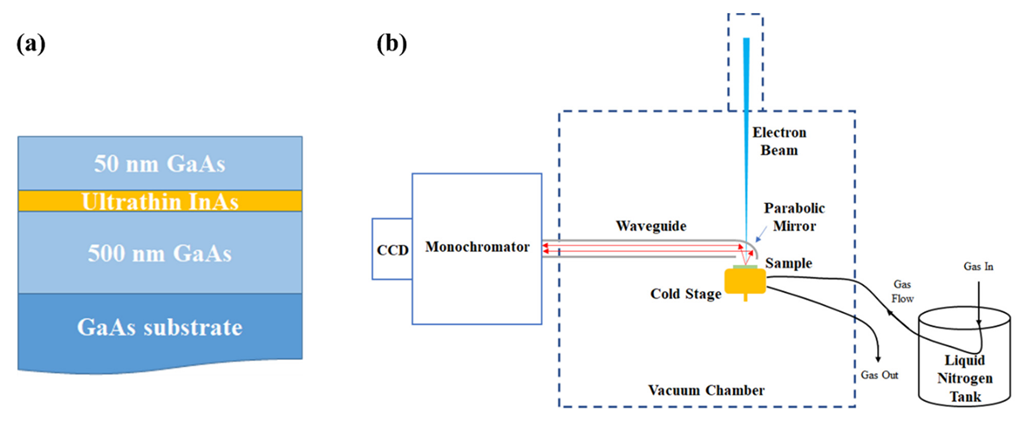
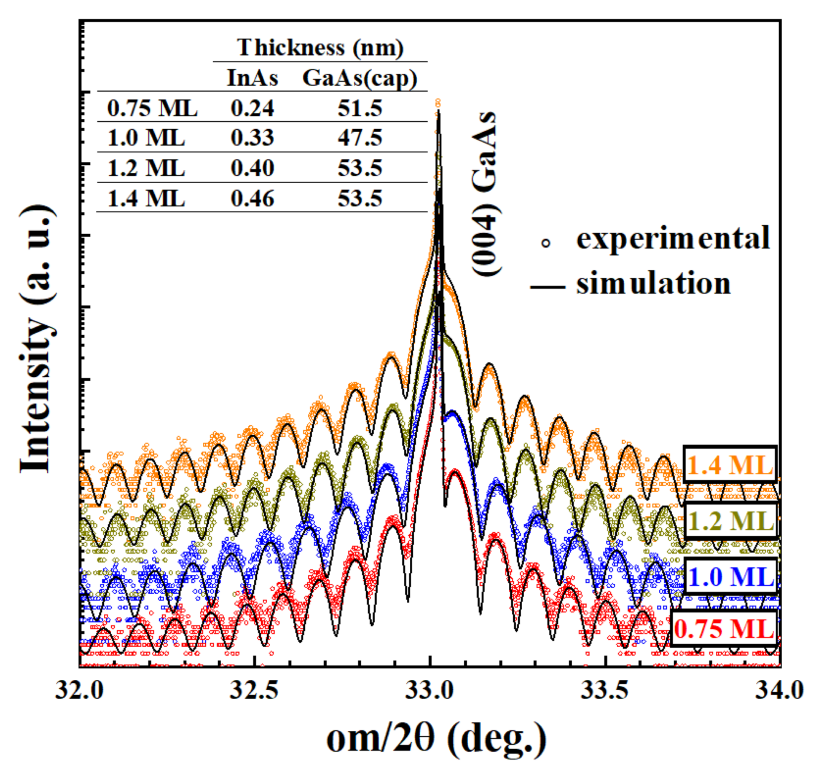
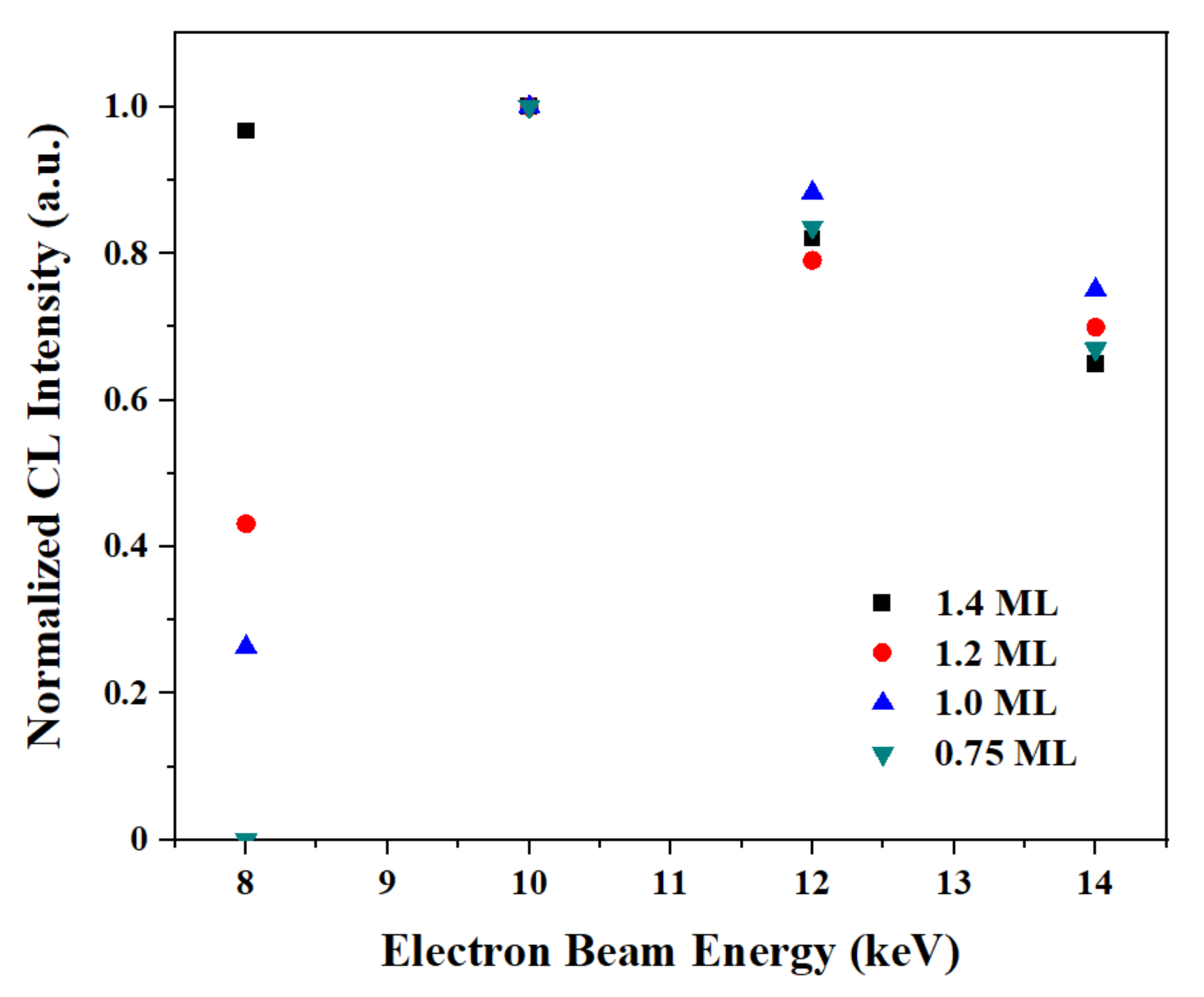
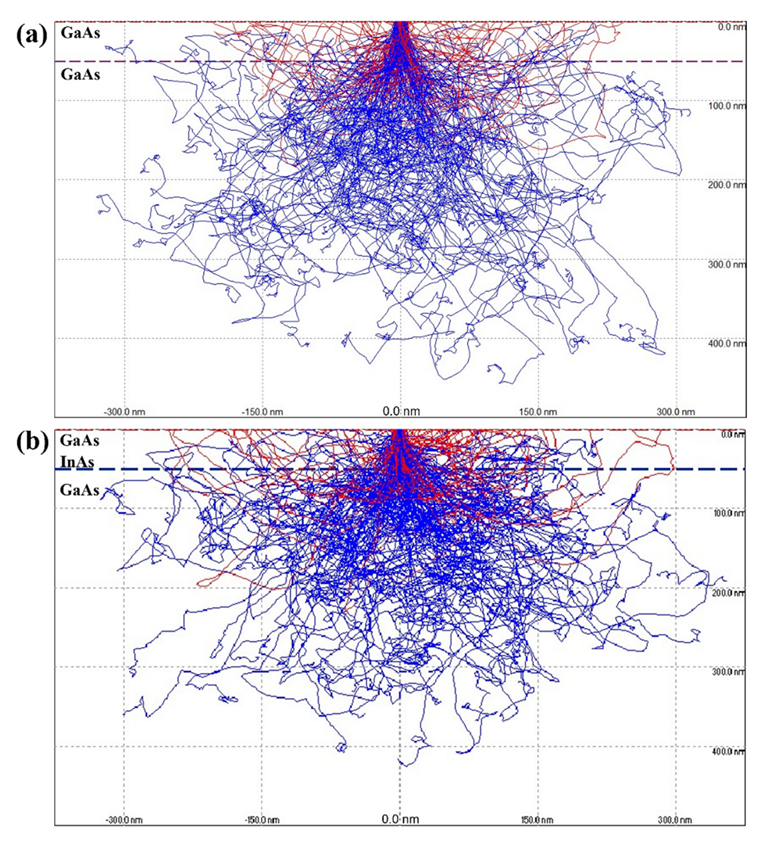
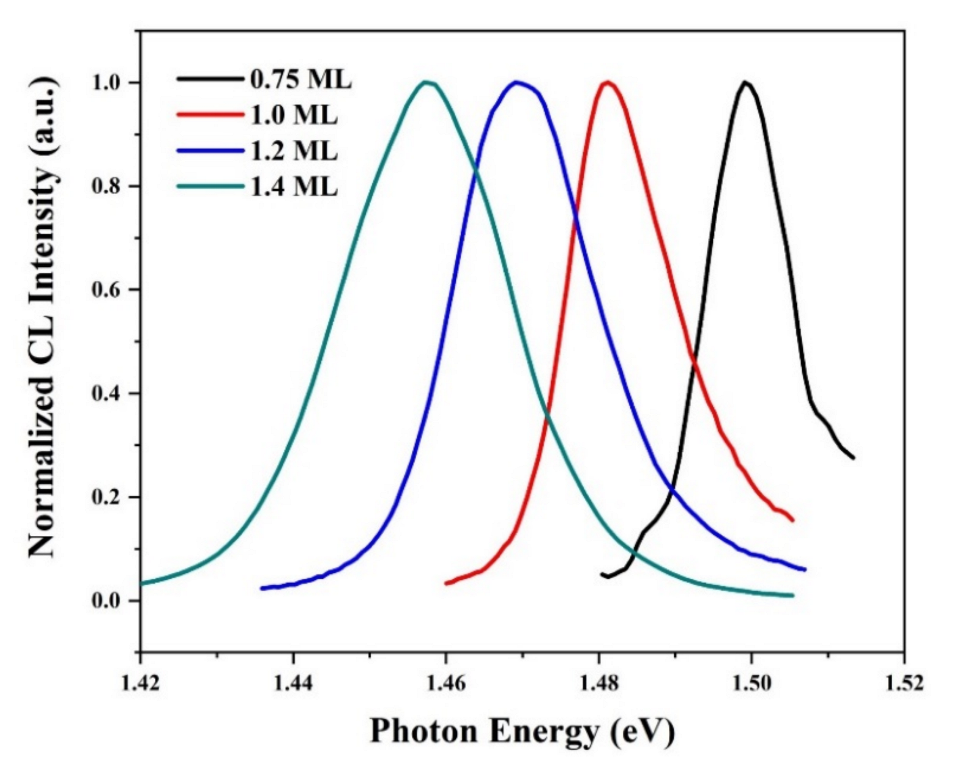
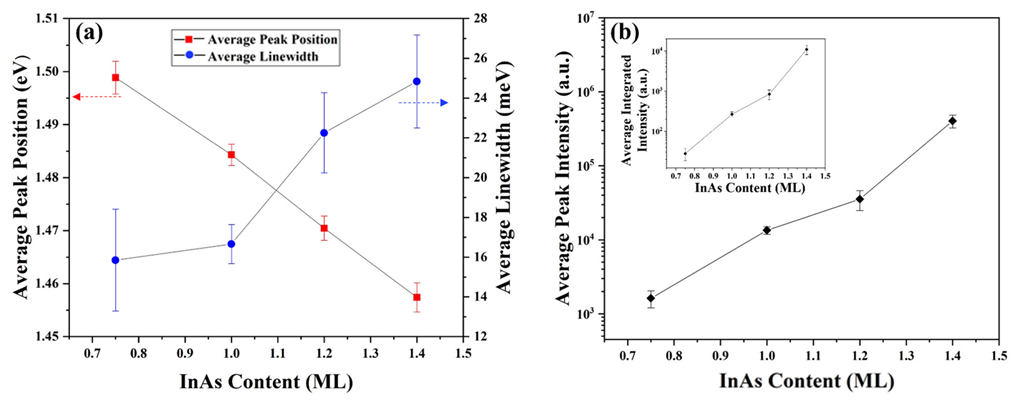
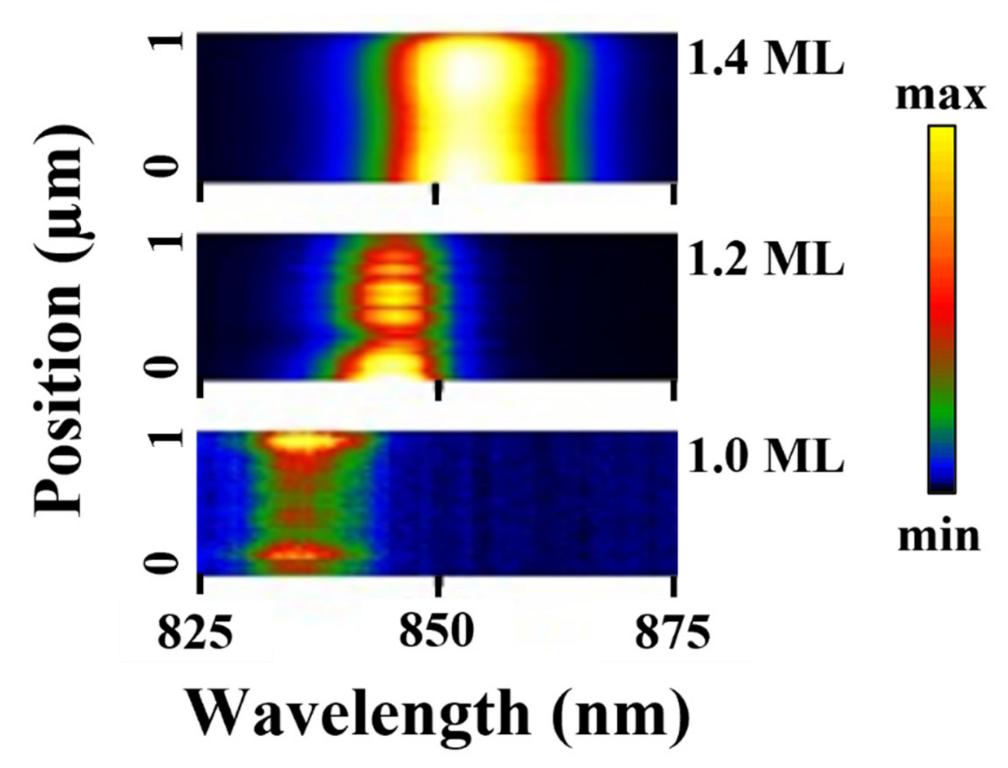
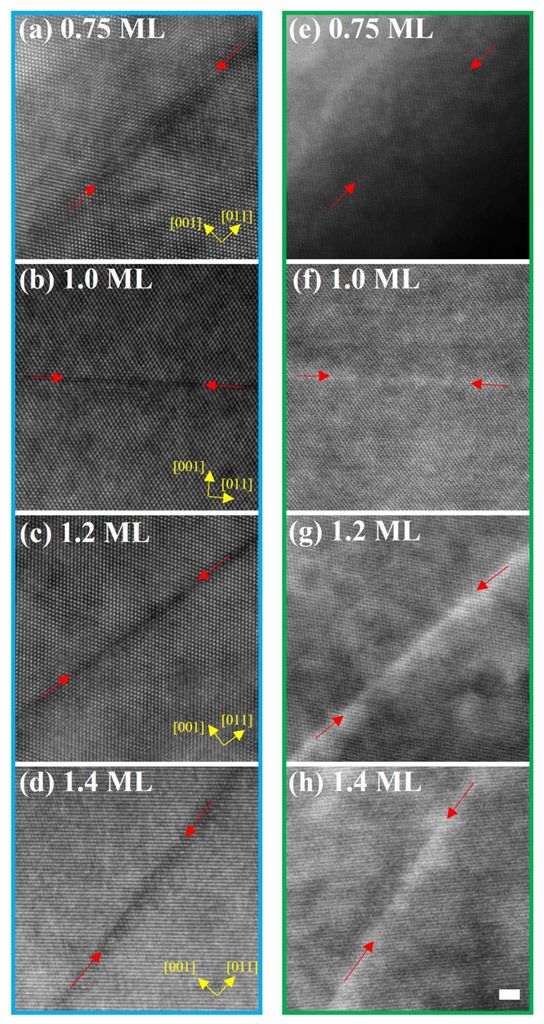
Publisher’s Note: MDPI stays neutral with regard to jurisdictional claims in published maps and institutional affiliations. |
© 2022 by the authors. Licensee MDPI, Basel, Switzerland. This article is an open access article distributed under the terms and conditions of the Creative Commons Attribution (CC BY) license (https://creativecommons.org/licenses/by/4.0/).
Share and Cite
Yan, Q.; Wang, S.; Guan, X.; He, L.; Sun, K.; Liang, B. Cathodoluminescence of Ultrathin InAs Layers Embedded in GaAs Matrix. Crystals 2022, 12, 1225. https://doi.org/10.3390/cryst12091225
Yan Q, Wang S, Guan X, He L, Sun K, Liang B. Cathodoluminescence of Ultrathin InAs Layers Embedded in GaAs Matrix. Crystals. 2022; 12(9):1225. https://doi.org/10.3390/cryst12091225
Chicago/Turabian StyleYan, Qigeng, Siyuan Wang, Xiaojin Guan, Lei He, Kesheng Sun, and Baolai Liang. 2022. "Cathodoluminescence of Ultrathin InAs Layers Embedded in GaAs Matrix" Crystals 12, no. 9: 1225. https://doi.org/10.3390/cryst12091225
APA StyleYan, Q., Wang, S., Guan, X., He, L., Sun, K., & Liang, B. (2022). Cathodoluminescence of Ultrathin InAs Layers Embedded in GaAs Matrix. Crystals, 12(9), 1225. https://doi.org/10.3390/cryst12091225




